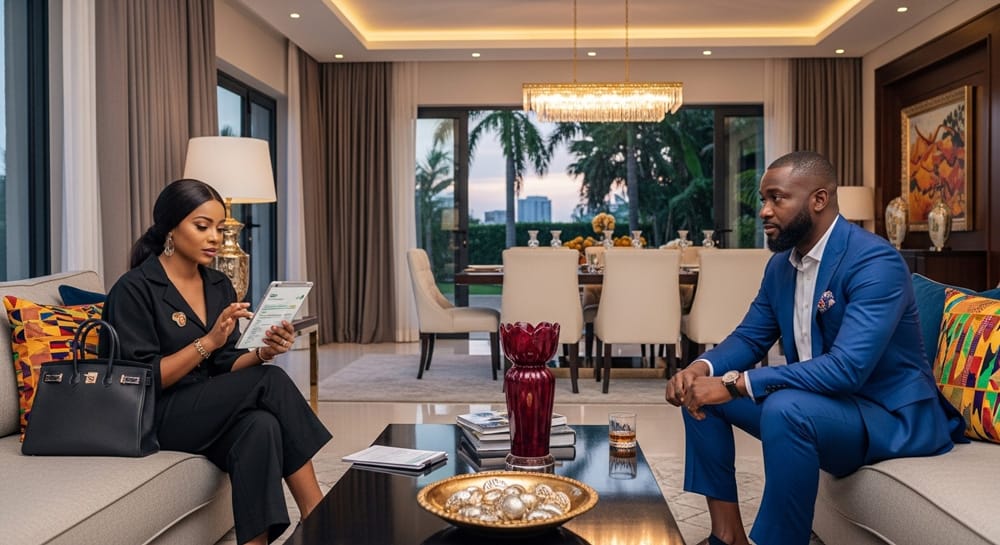Solo Sunrise papaya, a high-value tropical fruit developed in Hawaii, is rapidly gaining traction Papaya cultivation in Ghana‘s horticultural sector due to its premium quality, export potential, and suitability for smallholder farmers. This guide offers a complete blueprint for farmers, agripreneurs, and investors looking to grow Solo Sunrise papaya successfully in Ghana.
Solo Sunrise Papaya: Key Traits and Market Potential
- Origin: Hawaiian-bred cultivar from the “Solo” group of papayas, prized for small, sweet, single-serving fruits.
- Fruit Characteristics: Weighs ~450–650g, reddish-orange sweet flesh, firm yellow-orange skin, rich in vitamins A, C, and digestive enzymes.
- Productivity: Bears early (≈6 months), often hermaphroditic (self-fruiting), yielding up to 100 fruits/tree/year.
- Market Use: Highly demanded for exports, especially to Europe and the US, due to its taste, size, and long shelf life.
Why Solo Sunrise Papaya is Ideal for Ghana
- Agro-ecological Fit: Thrives in Ghana’s tropical climate zones—particularly Eastern, Central, Volta, and Greater Accra regions.
- High Yield Potential: Under proper care, yields can reach 30–40 tons/acre/year.
- Export Advantage: Ghanaian Solo Sunrise papaya aligns with global market demands for size, shelf-life, and sweetness.
Climate and Site Selection in Ghana
- Temperature: Optimal range is 21–32°C. Sensitive to frost and temperatures below 10°C.
- Rainfall: Requires 1,000–1,500mm/year. Prefers regions with bimodal rainfall for sustained fruiting.
- Regions: Ideal zones include Eastern (uniform rainfall), Volta Basin, Central Forest Zone, and Accra Plains.
- Soil Type: Light to medium-textured, well-drained soils with high organic matter.
- Soil pH: 5.5–6.5 is ideal. Apply lime if below 5.5.
- Avoid: Flood-prone, poorly drained, or heavy clay soils.
Cultivation Guide for Solo Sunrise Papaya
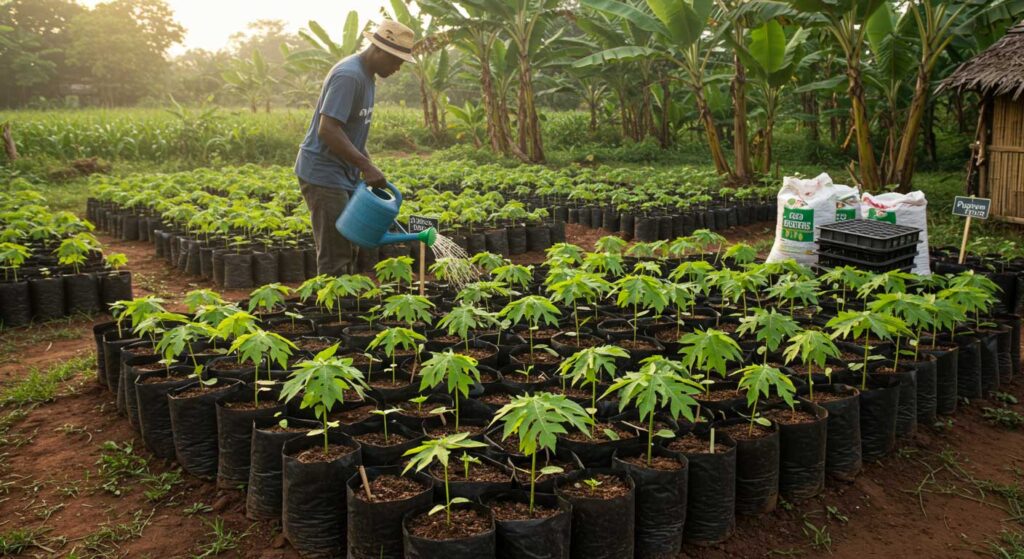
1. Nursery Preparation
- Use seeds from ripe yellow fruits.
- Wash and dry seeds for 1–2 days.
- Sow 1–2 cm deep in trays or polybags.
- Germinate under partial shade, water regularly.
- Transplant after 6–8 weeks once seedlings are 20–30cm tall.
2. Land Preparation
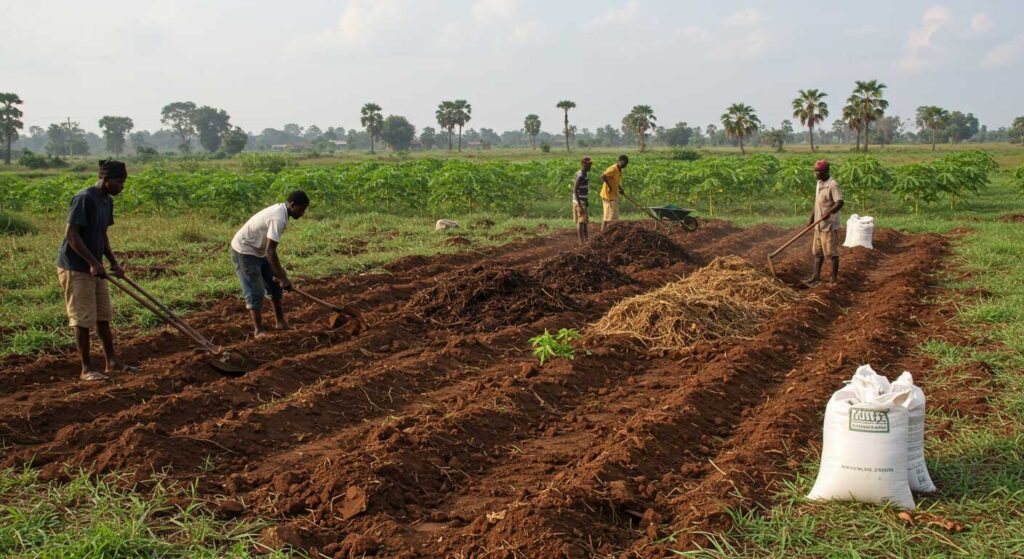
- Clear land, plow deeply to break compaction.
- Incorporate 2–3kg of well-rotted manure or compost into planting holes (~30–50 cm deep and wide).
- Adjust soil pH with lime as needed.
3. Spacing
- Use 2.5m x 2.5m spacing (~1,600 trees/ha).
- Wider spacing (up to 3m) recommended for better air flow and disease control.
4. Planting
- Plant at start of rainy season (March–May).
- Maintain root ball integrity when transplanting.
- Water immediately after planting.
5. Irrigation
- Drip or basin irrigation 2–3 times/week during dry periods.
- Avoid overwatering to prevent root rot.
- Mulch to conserve moisture and suppress weeds.
6. Fertilization
- Apply NPK 15-15-15 or 20-10-20 monthly.
- Add chicken manure or compost tea every 3–4 months.
- Supplement with micronutrients (Mg, B, Zn, Ca).
7. Weed and Pest Control
- Weed manually or with shallow hoeing.
- Use black plastic mulch or organic materials.
- Control mealybugs, aphids, whiteflies, and spider mites with neem oil, insecticidal soap, and IPM techniques.
Pest and Disease Management
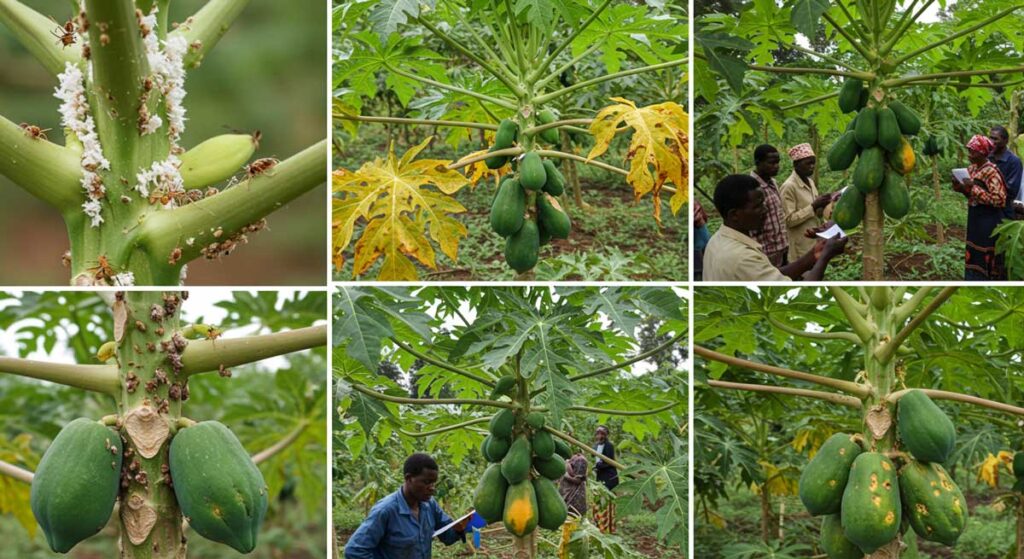
Major Threats
- Papaya Mealybug: Caused 85% crop loss in 2009; now managed with biocontrol (parasitic wasps).
- Papaya Ringspot Virus (PRSV): Spread by aphids; destroys plant vigor and fruit quality.
- Fungal Diseases: Anthracnose, black spot, and powdery mildew.
Management Practices
- Use certified disease-free seedlings.
- Practice crop hygiene and sanitation.
- Uproot and destroy infected plants.
- Apply hot water treatment or safe fungicides post-harvest.
Harvesting and Post-harvest Management
Harvesting
- First harvest: ~6–9 months after planting.
- Harvest 1–2 times/week.
- For export: Pick when fruit tip is light yellow; for local market, wait until fully yellow.
Handling
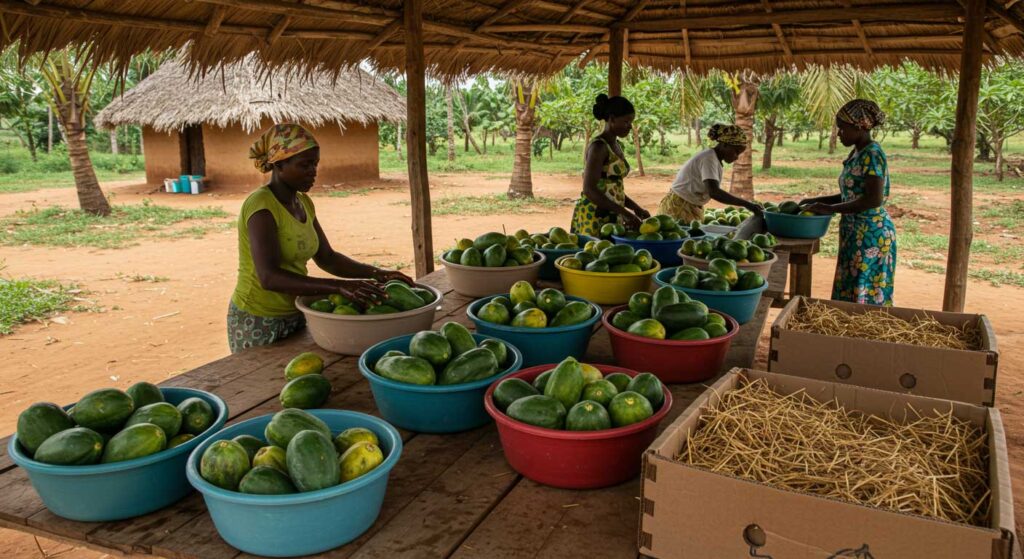
- Handle fruits carefully to avoid bruising.
- Wash, grade, and pack by size (400–700g typical for export).
- Use ventilated boxes with padding.
- Store at 7–12°C with high humidity; pre-cool at 12–15°C.
- Maintain cold chain to ensure shelf-life.
Challenges and Practical Solutions
Infrastructure
- Lack of cold storage, packhouses, and trained labor limits export potential.
- Solution: Invest in cooperative packhouses, solar cold rooms, and farmer training programs.
Yield Variability
- Irrigation inconsistency and poor nutrition reduce fruiting.
- Solution: Implement water harvesting systems, fertigation, and soil testing.
Market Access
- Export channels are limited by quality control lapses and inconsistent supply.
- Solution: Organize into farmer groups, maintain strict post-harvest protocols, and partner with export aggregators.
Economic Potential
- ROI: Solo Sunrise cultivation offers high returns with potential revenue of $8,000–$15,000/acre/year depending on management and market access.
- Market Demand: Growing global demand for exotic tropical fruits.
- Job Creation: Opportunities in farming, processing, logistics, and exports.
Conclusion: A Profitable Path for Ghanaian Agripreneurs
Solo Sunrise papaya offers a golden opportunity for Ghana’s farmers and agribusinesses. With the right practices—from site selection to post-harvest handling—farmers can tap into high-yielding, export-grade fruit production. Supported by Ghana’s favorable climate and growing global demand, Solo Sunrise cultivation is a sustainable, profitable crop for both local and export markets.
Keywords Used
- Solo Sunrise Papaya Ghana
- How to grow pawpaw in Ghana
- Export papaya varieties Ghana
- Best papaya farming practices
- Tropical fruit farming Ghana
- Papaya cultivation guide Ghana
- High yield papaya farming
- Ghana Solo papaya export
- Organic papaya production
- Papaya pest and disease control
Resources
- FAO (www.fao.org)
- Agroduka (www.agroduka.com)
- Logees (www.logees.com)
- Green Seeds (www.greenseeds.net)
- CTAHR Hawaii (www.ctahr.hawaii.edu)
- CBI (www.cbi.eu)
- Paramount Seeds (www.paramountseeds.com)
- Ghana Horticulture Foundation (www.gh-f.org)



